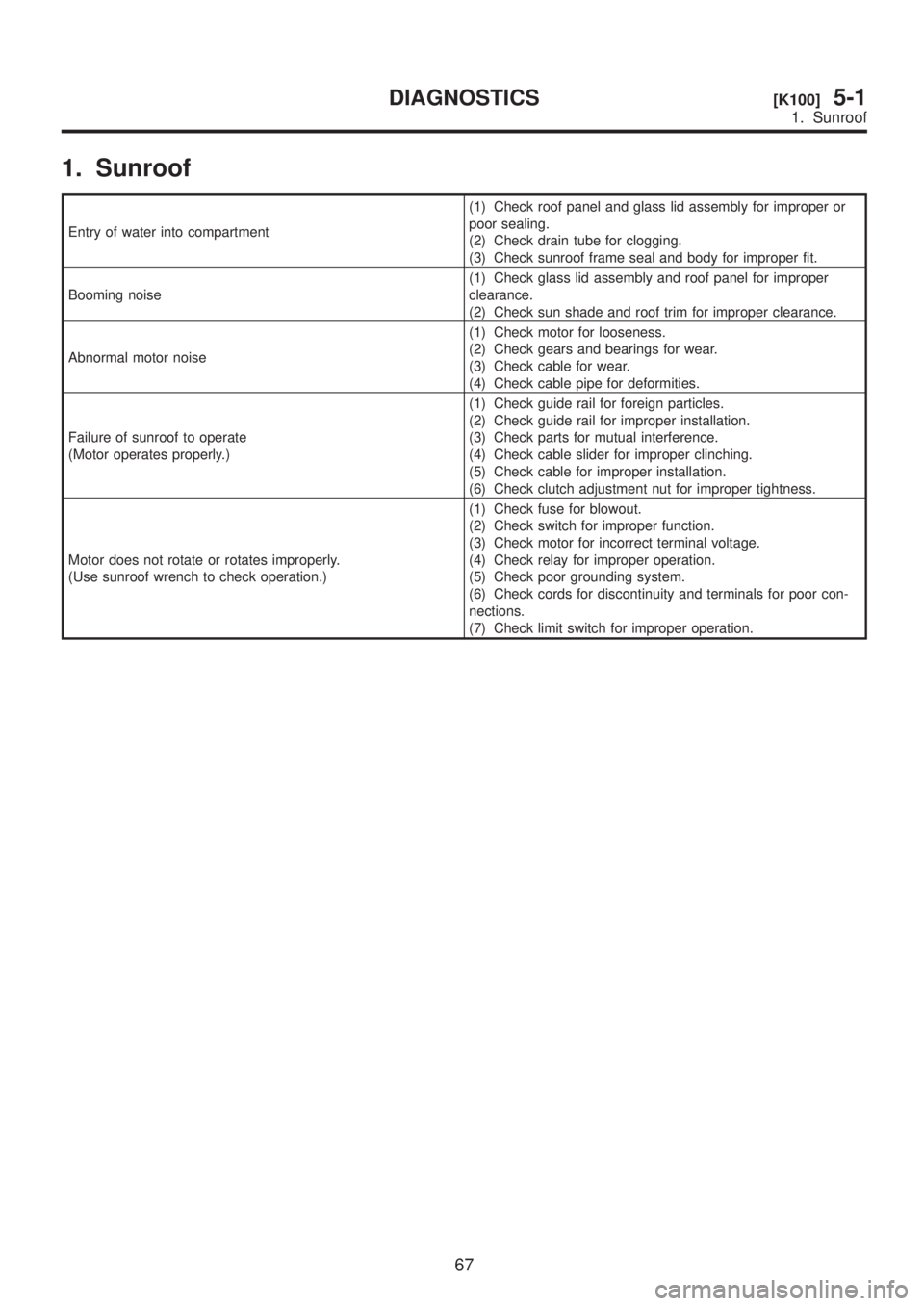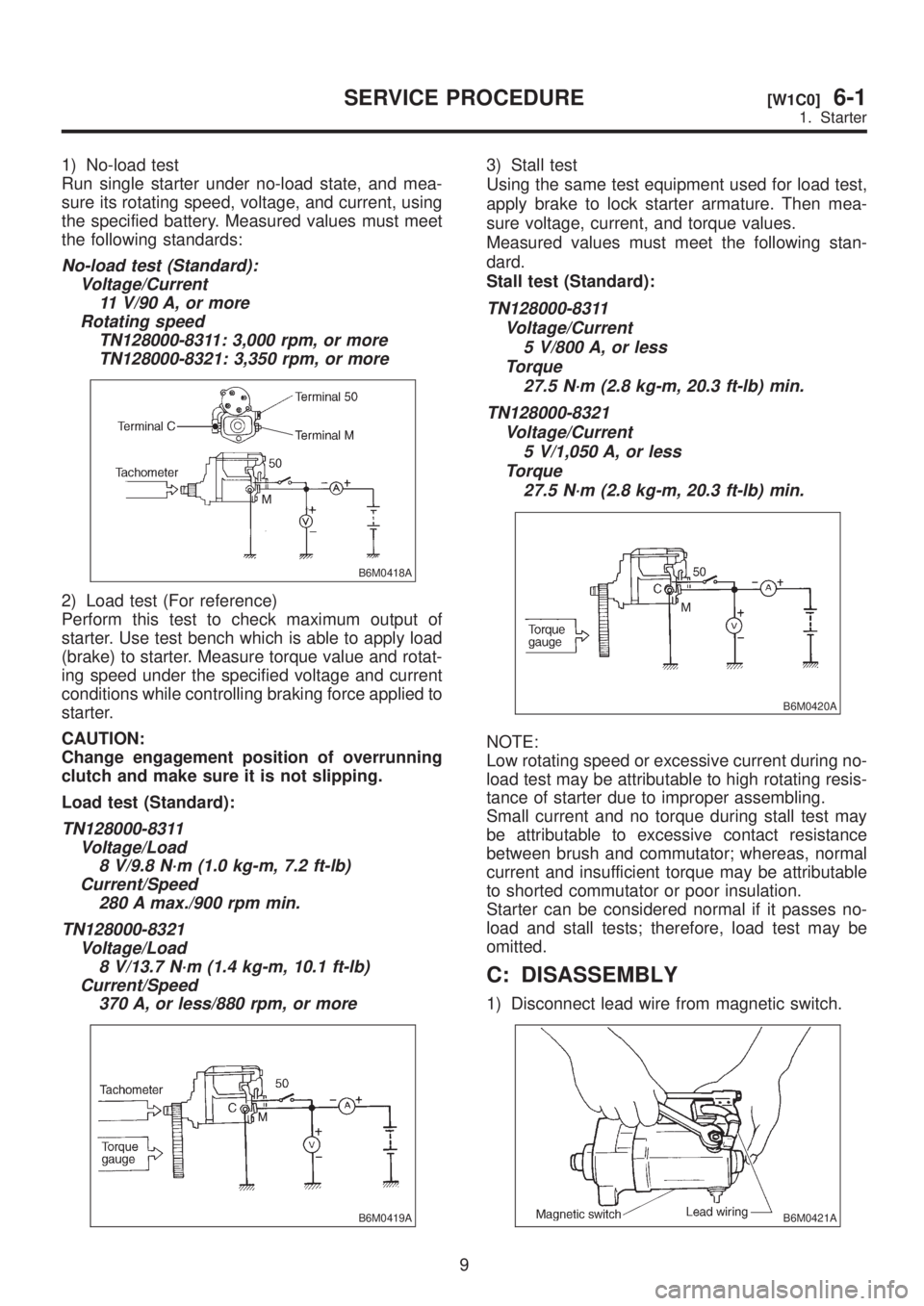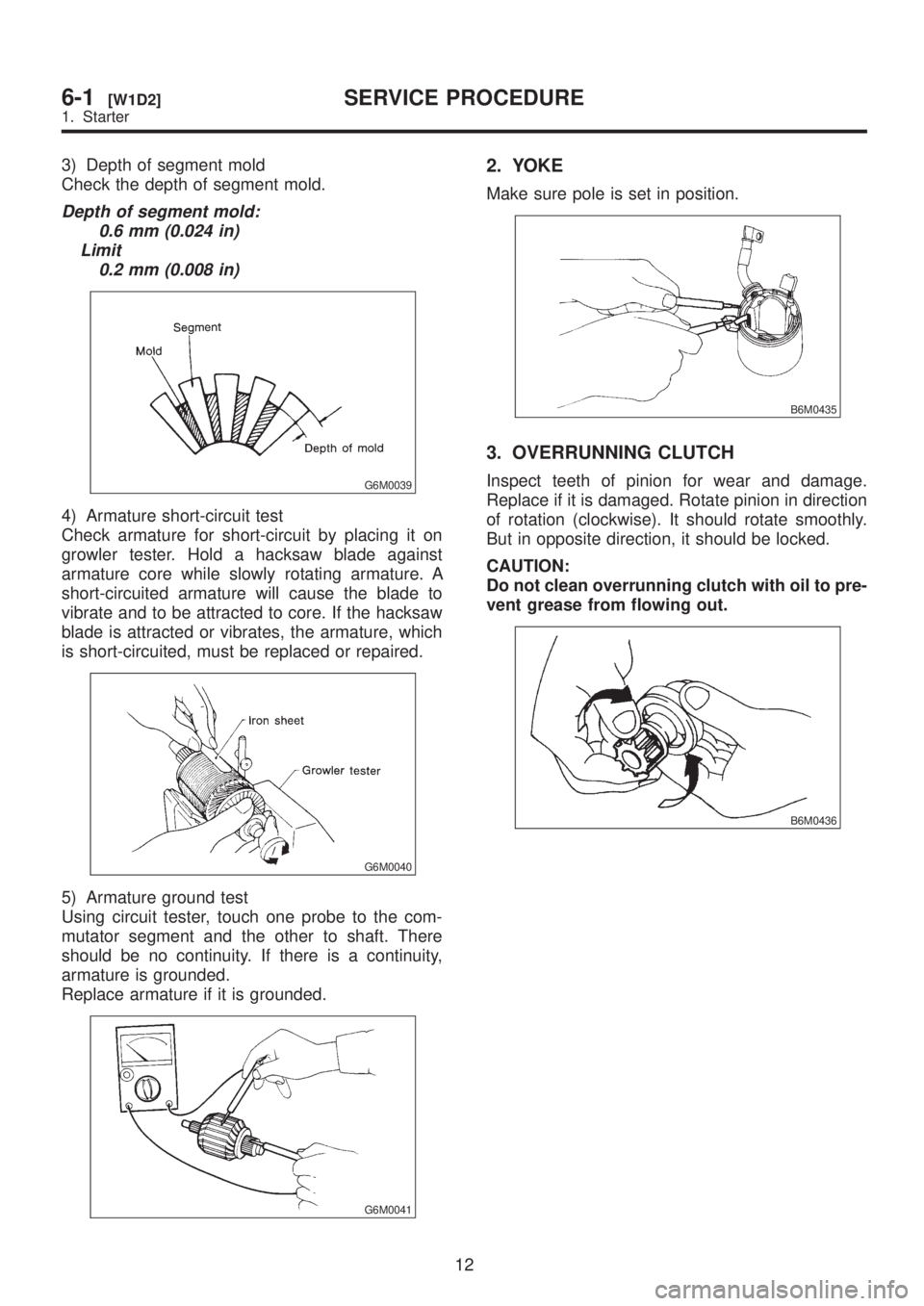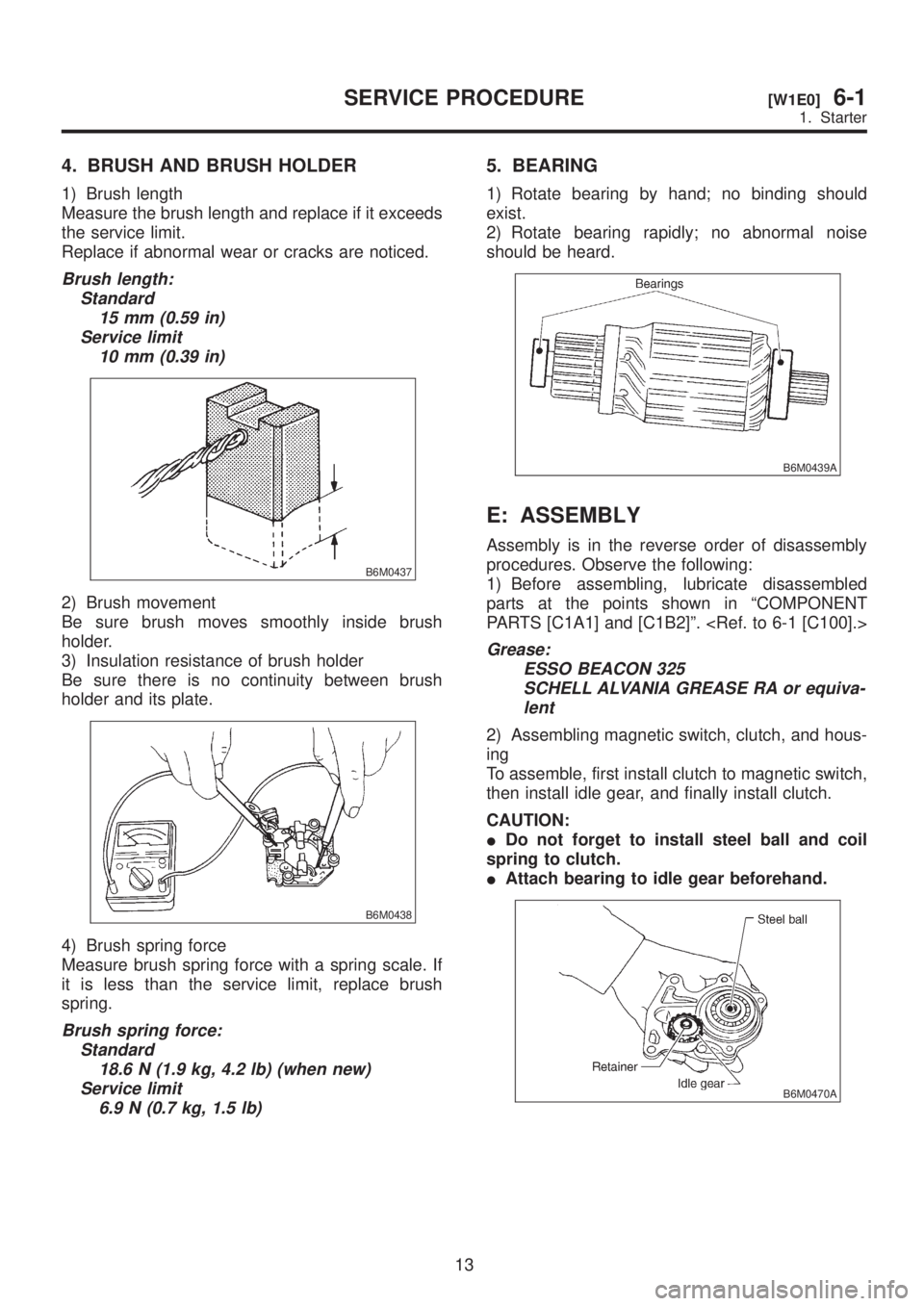Page 1021 of 1456
B4M1106A
41
[K500]4-7DIAGNOSTICS
5. Compressor Clutch Diagnosis
Page 1099 of 1456

1. Sunroof
Entry of water into compartment(1) Check roof panel and glass lid assembly for improper or
poor sealing.
(2) Check drain tube for clogging.
(3) Check sunroof frame seal and body for improper fit.
Booming noise(1) Check glass lid assembly and roof panel for improper
clearance.
(2) Check sun shade and roof trim for improper clearance.
Abnormal motor noise(1) Check motor for looseness.
(2) Check gears and bearings for wear.
(3) Check cable for wear.
(4) Check cable pipe for deformities.
Failure of sunroof to operate
(Motor operates properly.)(1) Check guide rail for foreign particles.
(2) Check guide rail for improper installation.
(3) Check parts for mutual interference.
(4) Check cable slider for improper clinching.
(5) Check cable for improper installation.
(6) Check clutch adjustment nut for improper tightness.
Motor does not rotate or rotates improperly.
(Use sunroof wrench to check operation.)(1) Check fuse for blowout.
(2) Check switch for improper function.
(3) Check motor for incorrect terminal voltage.
(4) Check relay for improper operation.
(5) Check poor grounding system.
(6) Check cords for discontinuity and terminals for poor con-
nections.
(7) Check limit switch for improper operation.
67
[K100]5-1DIAGNOSTICS
1. Sunroof
Page 1185 of 1456
1. Starter
A: MT VEHICLES
1. MODEL: TN128000-8311
B6M0412B
(1) Front ball bearing
(2) Armature
(3) Rear ball bearing
(4) O-ring
(5) Yoke
(6) Brush spring
(7) Brush holder
(8) End frame(9) Screw & washer
(10) Cover
(11) Through bolt
(12) Screw & washer
(13) Starter housing
(14) Overrunning clutch
(15) Steel ball
(16) Spring(17) Retainer
(18) Roller
(19) Idle gear
(20) Nut
(21) Spring washer
(22) Magnet switch
(23) Nut
4
6-1[C1A1]COMPONENT PARTS
1. Starter
Page 1186 of 1456
B: AT VEHICLES
1. MODEL: TN128000-8321
B6M0413B
(1) Front ball bearing
(2) Armature
(3) Rear ball bearing
(4) O-ring
(5) Yoke
(6) Brush spring
(7) Brush holder
(8) End frame(9) Cover
(10) Screw & washer
(11) Through bolt
(12) Screw & washer
(13) Starter housing
(14) Overrunning clutch
(15) Steel ball
(16) Spring(17) Retainer
(18) Roller
(19) Idle gear
(20) Nut
(21) Spring washer
(22) Magnet switch
(23) Nut
5
[C1B1]6-1COMPONENT PARTS
1. Starter
Page 1190 of 1456

1) No-load test
Run single starter under no-load state, and mea-
sure its rotating speed, voltage, and current, using
the specified battery. Measured values must meet
the following standards:
No-load test (Standard):
Voltage/Current
11 V/90 A, or more
Rotating speed
TN128000-8311: 3,000 rpm, or more
TN128000-8321: 3,350 rpm, or more
B6M0418A
2) Load test (For reference)
Perform this test to check maximum output of
starter. Use test bench which is able to apply load
(brake) to starter. Measure torque value and rotat-
ing speed under the specified voltage and current
conditions while controlling braking force applied to
starter.
CAUTION:
Change engagement position of overrunning
clutch and make sure it is not slipping.
Load test (Standard):
TN128000-8311
Voltage/Load
8 V/9.8 N´m (1.0 kg-m, 7.2 ft-lb)
Current/Speed
280 A max./900 rpm min.
TN128000-8321
Voltage/Load
8 V/13.7 N´m (1.4 kg-m, 10.1 ft-lb)
Current/Speed
370 A, or less/880 rpm, or more
B6M0419A
3) Stall test
Using the same test equipment used for load test,
apply brake to lock starter armature. Then mea-
sure voltage, current, and torque values.
Measured values must meet the following stan-
dard.
Stall test (Standard):
TN128000-8311
Voltage/Current
5 V/800 A, or less
Torque
27.5 N´m (2.8 kg-m, 20.3 ft-lb) min.
TN128000-8321
Voltage/Current
5 V/1,050 A, or less
Torque
27.5 N´m (2.8 kg-m, 20.3 ft-lb) min.
B6M0420A
NOTE:
Low rotating speed or excessive current during no-
load test may be attributable to high rotating resis-
tance of starter due to improper assembling.
Small current and no torque during stall test may
be attributable to excessive contact resistance
between brush and commutator; whereas, normal
current and insufficient torque may be attributable
to shorted commutator or poor insulation.
Starter can be considered normal if it passes no-
load and stall tests; therefore, load test may be
omitted.
C: DISASSEMBLY
1) Disconnect lead wire from magnetic switch.
B6M0421A
9
[W1C0]6-1SERVICE PROCEDURE
1. Starter
Page 1192 of 1456
9) Remove housing from magnetic switch.
B6M0429A
10) Remove clutch from housing.
B6M0430A
11) Take out steel ball from clutch.
CAUTION:
Be careful not to lose steel ball.
B6M0431A
12) Remove idle gear from housing.
B6M0432A
13) Remove retainer and roller from housing.
CAUTION:
Be careful not to drop retainer and roller.
B6M0433A
14) Remove coil spring from magnetic switch.
B6M0434A
D: INSPECTION
1. ARMATURE
1) Check commutator for any sign of burns of
rough surfaces or stepped wear. If wear is of a
minor nature, correct it by using sand paper.
2) Run-out test
Check the commutator run-out and replace if it
exceeds the limit.
Commutator run-out:
Standard
0.02 mm (0.0008 in), or less
Service limit
Less than 0.05 mm (0.0020 in)
G6M0038
11
[W1D1]6-1SERVICE PROCEDURE
1. Starter
Page 1193 of 1456

3) Depth of segment mold
Check the depth of segment mold.
Depth of segment mold:
0.6 mm (0.024 in)
Limit
0.2 mm (0.008 in)
G6M0039
4) Armature short-circuit test
Check armature for short-circuit by placing it on
growler tester. Hold a hacksaw blade against
armature core while slowly rotating armature. A
short-circuited armature will cause the blade to
vibrate and to be attracted to core. If the hacksaw
blade is attracted or vibrates, the armature, which
is short-circuited, must be replaced or repaired.
G6M0040
5) Armature ground test
Using circuit tester, touch one probe to the com-
mutator segment and the other to shaft. There
should be no continuity. If there is a continuity,
armature is grounded.
Replace armature if it is grounded.
G6M0041
2. YOKE
Make sure pole is set in position.
B6M0435
3. OVERRUNNING CLUTCH
Inspect teeth of pinion for wear and damage.
Replace if it is damaged. Rotate pinion in direction
of rotation (clockwise). It should rotate smoothly.
But in opposite direction, it should be locked.
CAUTION:
Do not clean overrunning clutch with oil to pre-
vent grease from flowing out.
B6M0436
12
6-1[W1D2]SERVICE PROCEDURE
1. Starter
Page 1194 of 1456

4. BRUSH AND BRUSH HOLDER
1) Brush length
Measure the brush length and replace if it exceeds
the service limit.
Replace if abnormal wear or cracks are noticed.
Brush length:
Standard
15 mm (0.59 in)
Service limit
10 mm (0.39 in)
B6M0437
2) Brush movement
Be sure brush moves smoothly inside brush
holder.
3) Insulation resistance of brush holder
Be sure there is no continuity between brush
holder and its plate.
B6M0438
4) Brush spring force
Measure brush spring force with a spring scale. If
it is less than the service limit, replace brush
spring.
Brush spring force:
Standard
18.6 N (1.9 kg, 4.2 lb) (when new)
Service limit
6.9 N (0.7 kg, 1.5 lb)
5. BEARING
1) Rotate bearing by hand; no binding should
exist.
2) Rotate bearing rapidly; no abnormal noise
should be heard.
B6M0439A
E: ASSEMBLY
Assembly is in the reverse order of disassembly
procedures. Observe the following:
1) Before assembling, lubricate disassembled
parts at the points shown in ªCOMPONENT
PARTS [C1A1] and [C1B2]º.
Grease:
ESSO BEACON 325
SCHELL ALVANIA GREASE RA or equiva-
lent
2) Assembling magnetic switch, clutch, and hous-
ing
To assemble, first install clutch to magnetic switch,
then install idle gear, and finally install clutch.
CAUTION:
IDo not forget to install steel ball and coil
spring to clutch.
IAttach bearing to idle gear beforehand.
B6M0470A
13
[W1E0]6-1SERVICE PROCEDURE
1. Starter